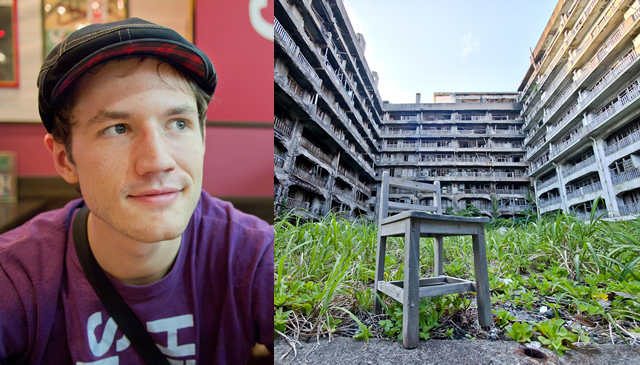Last year around springtime I wrote an article about Haikyo and my love of urban exploration for the Hiragana Times, in both English and Japanese. Up until now it was only available to see in the magazine version, but it was recently released online too. Here it is in full, English followed by Japanese.
Advanced learners should ignore the English at first and read just the Japanese, checking the translation if necessary. If you find that too difficult, try reading the English first to get an idea of the text before tackling the Japanese. Have fun!

**********
Hidden Beauty of Japan’s Abandoned Buildings
日本の廃墟の隠れた美しさ
I was first attracted to haikyo by the promise of adventure. The thrill of touring abandoned buildings and sneaking around places one probably shouldn’t go. The excitement of finding long-forgotten rooms and corridors littered with remnants of the past, of trying to piece together the scraps of history left behind. Grabbing my camera, I headed out to photograph a dilapidated structure. My first destination was an old hospital in northern England. As I tiptoed around my heart was in my throat.
廃墟には冒険があり、私はそこに魅力を感じました。行ってはならないような見捨てられた建物を探して、忍び込むスリル。前の時代から残されたものが散らばる、長い間見放されてきた部屋や廊下を見つけ、残された歴史のかけらをかき集めるわくわく感。私はカメラを手に、荒れ果てた建物を記録するために向かいます。最初の目的地は北イングランドにある古い病院でした。どきどきしながらも軽い足取りで歩き回りました。
Just what was lurking around this next corner? Why was this building left abandoned? Are these floors really safe to walk upon? I continued on, photographing the rusty relics I came across in each room and gradually building up a mental map of the structure. It was fascinating: a sign dangled down, ready to fall at any moment, and old patient records were strewn across the floor.
ここを曲がれば何が潜んでいるのだろう? この建物が見捨てられたのはなぜ? ここは本当に安全に歩けるのだろうか? 私は各部屋で出合うさびた遺物を撮り続けながらも、徐々に頭の中で当時の建物を描いていました。今すぐ落ちそうな状態でぶら下がっている看板や床に散らばる古びた患者のカルテなど、実におもしろいです。
At the time I was a student at university about to complete my joint honours degree in Philosophy and Japanese. After graduation I came to work in Japan, and here I found a wealth of abandoned bubble-era structures that continued to fuel my interest in urban exploration. Japan has a thriving subculture devoted to the pursuit. “Haikyo maniacs,” as they are sometimes labeled, are the equivalent of “urban explorers” overseas. As soon as I arrived, I headed down to the largest bookstore and discovered books detailing the subject with gorgeous photographs, historical records and accounts of nail-biting exploration.
その頃私は大学生で、哲学と日本語の専攻を終える時期でした。卒業後は、日本で就職しました。ここでは、バブル時代に見捨てられた建物を大量に発見し、本格的に都会の探検に活動の範囲を広げました。日本では廃墟探検をするサブカルチャーも盛んです。いわゆる日本の「廃墟マニア」は、海外の「アーバン・エクスプローラー」に相当します。日本に来るとすぐに、一番大きな本屋へ行き、廃墟に関する本を探しました。私の期待通りの見事な写真や歴史、廃墟探検の経験談などが掲載されている本を見つけました。
It’s been three years now since I began this hobby and I have been lucky enough to explore numerous abandoned buildings. From small, wooden medical shacks hidden deep in the countryside of central Japan, to sprawling hotel ruins in the subtropical regions of Okinawa, and deserted mines tucked away on mountains. Although the same excitement bubbles up within me on each excursion, throughout my explorations I’ve also begun to experience a very different set of feelings.
このアーバン・エクスプロレーションという趣味を持ち始めてから3年が経ちますが、運良くさまざまな廃墟を探検できました。日本の中心の自然あふれる場所に眠る、木造でできた小さな診療所をはじめ、亜熱帯気候の沖縄にある無秩序に散らばるホテルの廃墟、山に隠れるさびれた鉱山まであります。しかし、探検するたびに同様の感激はありますが、探検を通じて新たな感覚に気づきはじめました。
Present in many of the ruins is a sense of sadness. It comes from the places themselves: the cracks in the walls of buildings giving way to creeping plants, the tatami mats sagging from years of leaky ceilings, and the fading photographs. I’m reminded that we are transient beings, all part of the natural cycle of birth, growth, decay and eventual death. It’s also possible to associate these observations with wabi-sabi, an aesthetic rooted in the acceptance of the transience of things. For me, it is a lingering, forlorn feeling for what once was, coupled with awe at the sight of nature reclaiming things for its own. An aged and unforced harmony that conceals a hidden beauty.
それは、空間そのものから感じる廃墟の多くに存在する哀愁です。建物の壁の亀裂から伸びて生い茂る植物や十数年にわたり天井からの水もれで沈下していく畳、色あせていく写真。これらを見て私は、私たち人間は単なる一時的な存在であり、誕生、成長、衰退、そして死の自然な循環の一部であることを思い起こします。物事のはかなさを受け入れることに根ざす「わび・さび」という美意識に関連づけることもできます。それは私にとって、かつての姿を取り戻そうとするかのような光景と混ざり合った、いつまでも心に残る物悲しさです。そして、時間の経過とあるがままの調和の中に隠された美しさです。
But in addition to the beauty, there are also many dangers involved when exploring abandoned buildings. The structures are often unsafe and at risk of collapsing. Many also contain hazardous substances and are not well ventilated. It’s also important to be aware that entering a structure may be considered trespassing. For these reasons it is not something I recommend pursuing lightly and one should be fully aware of all the risks before even considering venturing outside.
このような魅力の一方で、廃墟探検には危険もたくさんあります。建物は安全ではなく倒れる危険性もあります。それらの多くに有害物質が含まれ通気もよくありません。そして、不法侵入と見なされる可能性もあることを知っておくべきです。そのため、簡単に勧められる趣味ではなく、廃墟の世界に入る前に全てのリスクを認識しておく必要があります。
However, for me urban exploration has become a never ending source of inspiration. It’s a chance to encounter scenes quite unlike those we come across in every day life and document them before their inevitable demise. Perhaps, too, we may learn something about the world and ourselves in the process.
しかし、私にとって廃墟を探検することは、終わりのないインスピレーションの源です。日常生活ではない場面に出合えることもあり、取り壊される前にもう一度記録するチャンスでもあります。そして、世の中や自分自身の事についても思いがけない発見があるかもしれないのです。
Michael Gakuran
マイケル・ガクラン
Leave a Reply